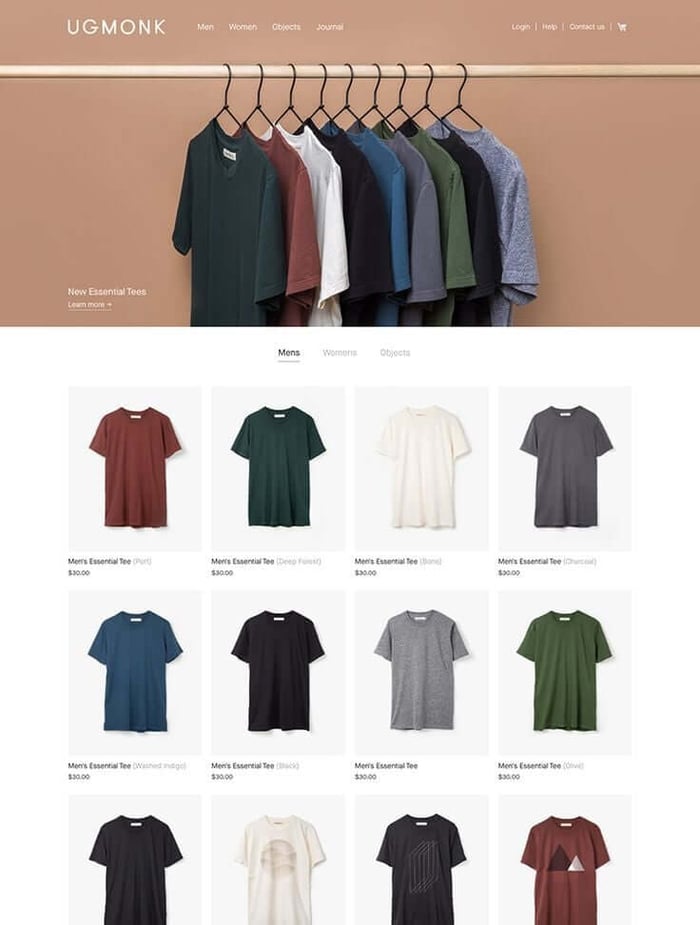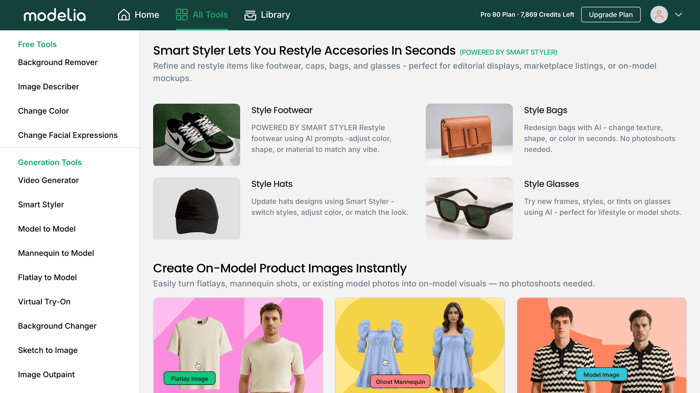How to Use AI in Ecommerce: Boost Your Sales and Optimize Customer Experience
Table of Contents
- What Is AI in Ecommerce?
- Why AI Matters
- How to Use AI in Ecommerce
- Modelia: Unlocking the Power of AI-Generated Visuals for Ecommerce
- Case Studies
- Choosing the Right AI Tools
-
- Getting Started with AI
- AI and Voice Commerce
- AI and Customer Retention
- AI for Fraud Detection and Security
- Using AI for Reviews and Sentiment Analysis
- AI and Personalization Beyond Shopping
- Final Thoughts
- FAQ: How to Use AI in Ecommerce
Artificial intelligence (AI) is reshaping the ecommerce landscape. From improving customer experiences to automating operations, AI is becoming essential for online retailers of all sizes. This guide explains how to use AI in ecommerce to drive more sales, enhance engagement, and operate more efficiently.
We’ll explore practical applications, real-life results, and tips on choosing the right tools for your business. Whether you're a small shop or an enterprise, understanding how to implement AI for ecommerce businesses is a step toward scaling smarter.
What Is AI in Ecommerce?
In ecommerce, AI refers to technologies that automate decisions and improve personalization based on data. It includes:
Machine learning: Predicts behavior and preferences
Natural language processing (NLP): Powers chatbots and search functions
Computer vision: Enables visual search and image recognition
Predictive analytics: Anticipates trends, demand, and customer needs
Together, these tools allow online stores to offer smarter, faster, and more personalized shopping experiences. AI is used both on the front end (customer-facing) and back end (operations, fulfillment).

Why AI Matters
AI helps ecommerce businesses:
Increase conversion rates through personalized product suggestions
Reduce customer service workload with chatbots
Optimize pricing in real time
Forecast inventory to prevent overstock and shortages
Improve marketing results with data-driven targeting
Accelerate content creation through automation
According to McKinsey, companies that adopt AI in commerce see 20–30% improvement in key performance metrics. In short, AI turns insights into action and scale.
How to Use AI in Ecommerce
Here are seven effective ways to implement AI in your online business:
1. Product Recommendations
Recommendation engines analyze user behavior to suggest relevant products, boosting upsell and cross-sell opportunities.
Examples:
“You may also like” sections
Suggested bundles in cart
Email follow ups with similar items
Brands using AI-driven recommendations often see 10–35% increases in order value.
2. Visual Search
AI allows users to search using images instead of keywords. Customers upload photos or screenshots to find similar products.
Why it matters:
Reduces friction in product discovery
Matches intent better than text search
Enhances mobile shopping experiences
Fashion and home decor brands benefit greatly from this feature.
3. Dynamic Pricing
AI monitors market conditions, competitor pricing, inventory levels, and user behavior to adjust prices automatically.
Benefits:
Maximizes profit margins
Responds instantly to demand shifts
Keeps pricing competitive
Retailers with large catalogs or frequent promotions see strong ROI.
4. Chatbots and Virtual Assistants
AI-powered chatbots provide 24/7 support, handling FAQs, order tracking, returns, and product guidance.
Results:
Cuts support costs by up to 50%
Improves response time
Increases customer satisfaction
Good bots integrate with CRM and ecommerce platforms for seamless interaction.
5. Email and SMS Personalization
AI analyzes purchase history and user behavior to send highly personalized messages.
Use cases:
Abandoned cart reminders
Post-purchase cross-sells
Re-engagement emails
Optimized send times and subject lines
AI-driven campaigns outperform traditional ones with 15–40% higher conversion rates.
6. Inventory Forecasting
Predictive models help stores forecast demand and restock efficiently.
Advantages:
Prevents stock-outs
Reduces excess inventory
Improves cash flow and logistics
AI-based demand planning is especially valuable during high-traffic seasons.
7. Image Generation
Tools like Modelia use AI to create high-quality product images by removing backgrounds, styling products, or generating variations.
Impact:
Cuts visual production time by up to 80%
Eliminates need for manual editing
Speeds up time to market
This is especially useful for fashion, beauty, and lifestyle brands with large catalogs.

Modelia: Unlocking the Power of AI-Generated Visuals for Ecommerce
When it comes to visual content creation, most ecommerce brands face the same challenges: long production timelines, high costs, and limited scalability. That’s where Modelia comes in, an AI visual platform built specifically for ecommerce brands that want to generate high-converting, on-brand product images in seconds.
What Makes Modelia Different?
Unlike generic image editors or overly rigid templates, Modelia uses advanced generative AI and computer vision to help you:
Instantly swap backgrounds, models, and styles
Generate lifestyle images from simple product shots
Create on-brand visuals with customizable guidelines
Adapt content to different markets, seasons, and channels
With Modelia, you get creative control without the production bottlenecks.
AI Use Cases for Ecommerce Brands
Modelia is already transforming how online retailers create and scale their visuals:
Fashion brands use it to generate model shots in various poses, skin tones, and settings without a physical photoshoot.
Marketplaces use Modelia to standardize catalog images across thousands of SKUs while preserving brand identity.
This means faster content production, better product discoverability, and higher engagement, without the usual overhead.

Save Time, Increase Conversions
Modelia customers report:
Up to 80% reduction in time to market for new product visuals
30–40% lower costs compared to traditional photoshoots
Significantly higher click-through rates on ads and product listings with on-brand AI visuals
It’s not just about replacing photoshoots, it’s about creating a more agile, data-driven, and scalable content strategy for your ecommerce business.
Ready to try it?
If you're exploring how to use AI in ecommerce, Modelia is one of the most impactful places to start. Whether you're a startup or an enterprise, it can help you elevate your product imagery, reduce your time-to-market, and deliver a better shopping experience automatically. Sign up and try Modelia for free!
Case Studies
Case 1: Mid-size Fashion Brand
This retailer implemented AI-powered product recommendations and saw:
18% increase in average order value
12% reduction in bounce rate
25% faster checkout
Case 2: Consumer Electronics Store
They used AI for dynamic pricing and chatbot support:
9% increase in net margin
40% drop in support tickets
Improved customer retention during peak season
These results show how AI for ecommerce businesses can deliver real, measurable outcomes.

Choosing the Right AI Tools
Not all AI tools are equal. Here’s what to consider:
Compatibility: Choose tools that integrate with your ecommerce platform (Shopify, WooCommerce, etc.)
Ease of use: Look for clean dashboards, tutorials, and support
Use case focus: Pick tools that solve your actual pain points (support, visuals, pricing, etc.)
Cost structure: Some charge per image or user, others by tier or monthly volume
Scalability: Make sure the platform grows with your store
Security: Ensure data compliance (especially for customer behavior and payment data)
Getting Started with AI
You don’t have to implement everything at once. Here’s a phased approach:
Start small: Try AI recommendations or a chatbot
Test and optimize: Measure performance over 30–60 days
Scale up: Add forecasting, visual tools, or dynamic pricing
Review regularly: AI gets better with data, refine settings as you grow
There are also many plug-and-play tools to get started with zero code required.
AI and Voice Commerce
Voice search is quickly changing how users shop online. Smart assistants like Alexa and Google Assistant are pushing more consumers to order via voice.
AI for ecommerce businesses enables voice based interactions by interpreting natural language, processing requests, and connecting to product databases.
A customer might say: “Order more organic coffee from my last order” and the system handles everything automatically. Implementing voice AI helps brands:
Be accessible across more channels
Serve differently abled users more inclusively
Speed up frequent purchases
Learning how to use AI in ecommerce through voice technology opens a new, fast-growing sales channel.

AI and Customer Retention
While acquiring customers is critical, retaining them is even more valuable. This is where AI for ecommerce businessesbecomes a powerful asset.
AI can analyze historical data, track user behavior, and predict which customers are at risk of churning. It can then trigger specific actions, personalized emails, loyalty offers, or reminders to re-engage them before they leave.
For example, if a customer frequently shops every 30 days but misses a cycle, the system can automatically offer a time limited discount or exclusive bundle. These proactive strategies keep engagement high and increase customer lifetime value.
Understanding how to use AI in ecommerce means going beyond conversion and into nurturing long-term relationships. With retention focused AI, brands not only reduce churn but also grow with more stable, predictable revenue.
AI for Fraud Detection and Security
Another underrated use of AI in ecommerce businesses is fraud detection. AI systems can monitor real-time transactions, flagging unusual behavior like:
Multiple purchases from the same IP with different cards
Drastic changes in buying patterns
Suspicious refund or return activity
These algorithms learn from past fraudulent cases and improve over time. This helps protect not just the business, but also the customer’s trust.
By mastering how to use AI in ecommerce security layers, brands reduce chargebacks, secure payment flows, and offer a safer shopping environment for users.
Using AI for Reviews and Sentiment Analysis
User generated content like product reviews is valuable, but hard to manage at scale. AI can help by automatically analyzing large volumes of reviews to understand sentiment, detect issues, and identify product insights.
Benefits for AI for ecommerce businesses include:
Quickly spotting negative reviews to address problems
Summarizing key praise points for product pages
Identifying trends like common fit issues or feature requests
Brands using AI for sentiment analysis improve product development and customer communication. If you want to truly understand how to use AI in ecommerce, this is a key area to explore.
AI and Personalization Beyond Shopping
AI doesn’t just personalize product offers, it can personalize the entire experience:
Displaying different homepage banners based on browsing behavior
Customizing the checkout process to show preferred shipping/payment options
Personalizing blog content or help guides depending on user goals
AI for ecommerce businesses allows every touchpoint to feel tailored. The deeper the personalization, the more likely a user will convert and return.
Businesses looking to maximize value need to understand how to use AI in ecommerce for deeper, multi-layered personalization.

Final Thoughts
Learning how to use AI in ecommerce is more than following a trend, it’s a strategy to future-proof your business. AI tools can help you personalize shopping, operate more efficiently, and increase customer satisfaction, all while reducing manual workload.
As more shoppers expect seamless, intelligent experiences, AI for ecommerce businesses becomes not just valuable, but essential.
Adopt it early. Use it wisely. And let it help you scale smarter.
Ready to enhance your e-commerce with AI? Try Modelia now and start tranforming your product
FAQ: How to Use AI in Ecommerce
What is AI in ecommerce?
AI in ecommerce refers to the use of artificial intelligence technologies to optimize online shopping experiences, from product recommendations and chatbots to inventory management and personalized marketing.
How can AI improve customer experience in ecommerce?
AI can provide personalized product suggestions, predictive search, automated customer support, and dynamic pricing, making shopping more relevant, faster, and enjoyable for customers.
What are the benefits of using AI for ecommerce businesses?
AI helps increase sales, reduce operational costs, improve inventory planning, enhance marketing strategies, and deliver insights into customer behavior, leading to better business decisions.
Which AI tools are commonly used in ecommerce?
Common tools include recommendation engines, chatbots, AI-powered product photography software, virtual fitting rooms, and analytics platforms that track and predict consumer trends.
How would you rate this article:
Related Articles
- Top fashion brands leveraging artificial intelligence in 2025
- Top 5 Image Quality Enhancer to Sharpen & Improve Photos
- Best AI Muppet Generators for 2026
- 5 AI Fashion Design Tools for Modern Fashion Designers
- Best Practices for Capturing High-Quality Mannequin Photos
- How to Create a Clothing Business Plan (Step-by-Step)
- AI Video Generator for Shopify
- How to Sell on Instagram: Tips for Turning Followers into Customers
- How to Dress for a Job Interview: Professional Outfits That Make an Impact
- Christmas Pajamas for the Whole Family



